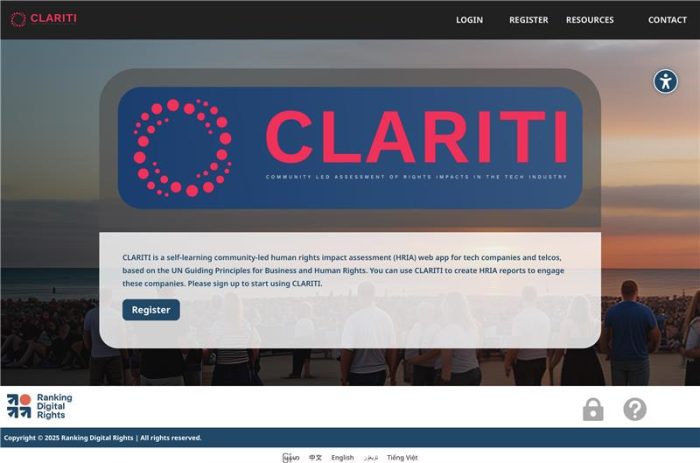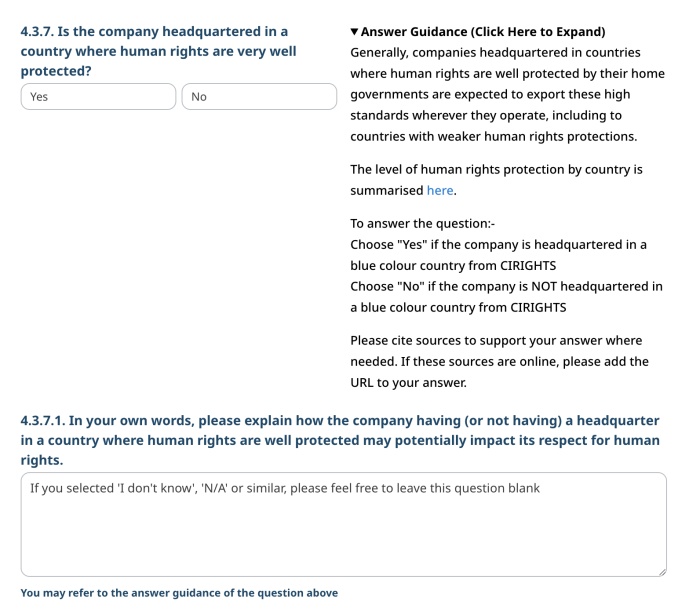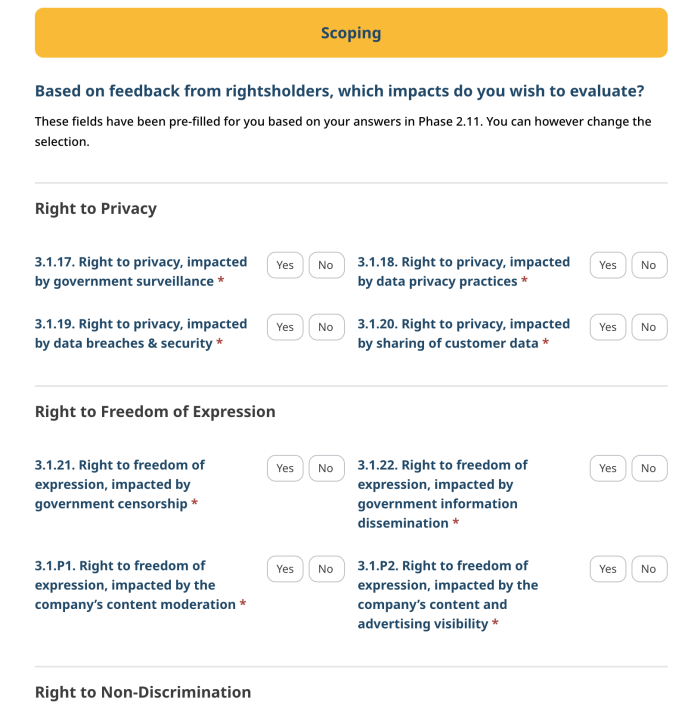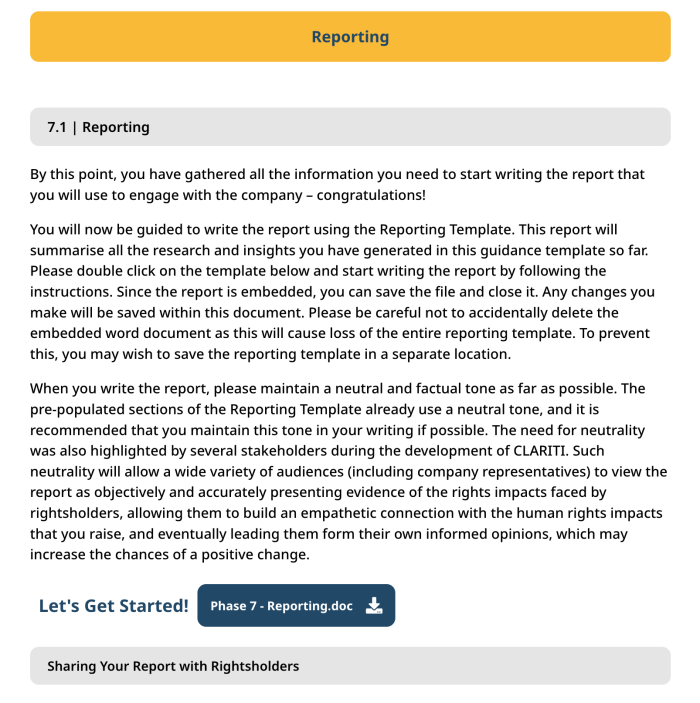Introducing CLARITI: A new tool for community-driven accountability of the tech industry

Imagine a social media service removing a journalist’s reporting on social protests at the behest of an authoritarian government. Or a platform allowing the rampant spread of disinformation from public authorities to suit their political narrative. Perhaps a telecommunication operator regularly providing user data from vulnerable communities to the government without appropriate due process. These are not hypothetical scenarios.
The effects of tech companies’ power, whether we notice it ourselves in daily life or experience it only indirectly, reverberates all over the world.
In Turkey, just this spring, X (formerly Twitter) suspended the accounts of political opposition figures. This came after 2024 was catalogued as the worst year on record for internet shutdowns, with 296 incidents in 54 countries. In Vietnam today, criticism of government officials on social media leads to censorship and silencing. China is well known for blocking access to most US-based digital services, while limiting access to VPNs and circumvention technologies to freely browse the web. These examples highlight how the rights to freedom of expression, access to information and privacy, are being undermined online.
These have been long-known issues amongst civil society groups championing for stronger human rights protections in the tech sector. But the resources needed to address the extent of the impacts at the local level are often limited.
CLARITI, which stands for Community-led Assessment of Rights Impacts in the Technology Industry, is a new tool and methodology to help communities hold digital services and telecommunications operators accountable. It does this by:
- Measuring the impact of company activities on rightsholders and advocating for needed changes;
-
Promoting constructive, long-term relationships between companies and the communities they affect, championing more rights-respecting behaviour from companies in turn.

Anyone can use CLARITI to conduct a Human Rights Impact Assessment (HRIA) grounded in the UN Guiding Principles on Business and Human Rights (UNGPs) to hold companies accountable through constructive engagement. CLARITI is designed with step-by-step instructions that make the process less intimidating for any newcomers to HRIAs, inspiring a learn-as-you-go experience. CLARITI walks you through the process, providing explanations and recommendations, so you don’t feel lost at any point. This makes generating a comprehensive and customised HRIA report faster and easier than with other HRIA methodologies.
Besides English, CLARITI is also available in the following languages: Burmese, Chinese, Uyghur, and Vietnamese.
CLARITI was created by Ranking Digital Rights as part of the Engaging Tech for Internet Freedom (ETIF) programme. Development began in mid-2023, with a review of existing methodologies for conducting Human Rights Impact Assessments. While several tools exist, they are geared primarily towards governments or companies, to facilitate their internal HRIA or Human Rights Due Diligence processes.
We, therefore, identified a gap: a tool that can help local communities in holding the tech sector accountable. Through this review, we also found that existing tools could serve as a strong foundation for the development of CLARITI.
CLARITI was further enhanced by two pilot projects, conducted between June and September 2024, by NGOs representing the rights of Vietnamese and Chinese social media platform users, Legal Initiatives for Vietnam (LIV) and Human Rights in China (HRIC), respectively. To better meet the needs of the rightsholder representatives, the final design of CLARITI also draws upon the methodology review and feedback from these two pilots.
Each pilot project focused on one major social media service: Legal Initiatives for Vietnam conducted an assessment of Facebook, while Human Rights in China conducted an assessment of X, formerly Twitter. CLARITI served as the basis for the reports that both organisations published showcasing their findings.
Who is CLARITI designed for?
CLARITI is designed to be used by NGOs, journalists, researchers, academics and human rights advocates, i.e.: the people who hold digital platforms and telcos accountable for the rest of society. But ultimately, CLARITI benefits anyone who is an end user of the products and services of digital platforms and telcos.
While CLARITI can be applied to any country, it was designed with particular consideration for rights holders in authoritarian and semi-authoritarian contexts where rights violations tend to be the greatest, and where authoritarian regimes may compel tech companies to act in line with restrictive laws and regulations.
What makes CLARITI easy?
CLARITI combines the strength of existing community-led and company-led methodologies to deliver a user experience that is accessible, intuitive and as inclusive as possible.
The CLARITI methodology includes eight phases to guide users through conducting a comprehensive HRIA.
- Phase 1 introduces CLARITI’s framework and alignment with the UN Guiding Principles (UNGPs).
- Phase 2 prepares the user by assembling the assessment team, defining objectives and planning logistics.
- Phase 3 helps users scope the assessment’s relevant sections based on stakeholder feedback and check that all preparatory steps from Phase 2 are complete.
-
Phase 4 is a context analysis that focuses on understanding the broader country, industry and company environment in which human rights impacts occur.
- Phase 5 is an impact assessment phase and involves answering relevant questions and scoring human rights impacts.
- Phase 6 is a recommendations phase that uses the analysis from previous phases to guide users in suggesting measures to mitigate and address identified implications for the company.
- Phase 7 is a reporting phase which helps users compile their findings and recommendations into a formal report.
- Phase 8 provides guidance to engage with companies and encourage positive change.
CLARITI is designed to be educational, allowing anyone with some research experience to use it, regardless of their experience conducting HRIAs. As shown in Figure [1], users are provided with extensive guidance and curated sources to help answer questions that analyse the context of the company’s operations and their impact on rights based on international human rights standards. These questions are tailored to the different contexts of the industry and country where the company operates, so that users logically identify relevant salient human rights impacts for a given situation and propose appropriate recommendations.

Figure [1] – Example of a question with detailed answer guidance and a curated source to help users answer the questions comprehensively.
CLARITI is also designed to be scalable – users can select from any of the 11 impacts on rights to freedom of expression, privacy and non-discrimination that companies may cause, contribute or be linked to. For an HRIA that needs to assess a wide range of rights impacts, all 11 modules can be evaluated. At the same time, a more targeted HRIA (such as those that took place during the CLARITI pilots) might only require that one to two such modules be evaluated. Users may also complete additional modules later to augment their analysis and recommendations.
This approach allows users to optimise between a comprehensive or targeted (i.e. issue-specific) HRIA at different points in time. As shown in the screenshot below (see Figure 2), users are only shown relevant impacts based on the type of company they have selected. For example, impacts on freedom of expression from government-ordered network disruptions are not shown for platform companies since this impact relates to telcos.

Figure 2: Users can choose which of 11 impacts to rights to freedom of expression, privacy and non-discrimination that they wish to assess using CLARITI.
The CLARITI methodology is designed to be intuitive and efficient. Outputs from preceding phases inform the inputs of subsequent phases, thereby creating a logical workflow that guides the inductive and deductive reasoning processes inherent to an HRIA.
Many people, myself included, have made strong claims about Facebook’s impact on human rights in Vietnam, particularly its effect on freedom of expression. CLARITI, however, enables us to examine this issue with much greater clarity and fairness. It brings an evidence-based approach that reduces exaggeration or understatement, and helps quantify the situation more accurately.
~ Trịnh Hữu Long, Interim Executive Director, Legal Initiatives for Vietnam
Furthermore, users are provided with ready-made templates to expedite the creation of graphs and reports. For example, the Phase 7 Reporting Template includes standard text describing the methodology users can leave unchanged. At the same time, guidance helps users paraphrase and import findings from the research completed in previous phases. A template in Phase 5 allows users to plot a graph that is later imported directly into the report of Phase 7, where it is used to prioritise rights impacts.

The CLARITI tool will be presented in-depth, together with the pilot experiences conducted by LIV and HIRC, at DRAPAC25, the Digital Rights in Asia-Pacific conference hosted this year in Kuala Lumpur, Malaysia during the session ‘Mission Invisible: How Collaboration Sparks Rights-Based Digital Change in Asia-Pacific based on Communities Feedback’ on Thursday 28th August, 2025.